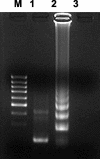Development and evaluation of a novel loop-mediated isothermal amplification method for rapid detection of severe acute respiratory syndrome coronavirus
- PMID: 15131154
- PMCID: PMC404656
- DOI: 10.1128/JCM.42.5.1956-1961.2004
Development and evaluation of a novel loop-mediated isothermal amplification method for rapid detection of severe acute respiratory syndrome coronavirus
Abstract
The development and evaluation of a one-step single-tube accelerated real-time quantitative reverse transcription (RT) loop-mediated isothermal amplification (LAMP) assay is reported for rapid detection of the severe acute respiratory syndrome coronavirus (SARS-CoV) replicase gene. A total of 49 samples (15 throat washes, 13 throat swabs, and 21 combined throat and nasal swabs) collected from patients admitted to the Hanoi-French and Ninhbinh hospitals in Vietnam during the SARS epidemic were evaluated and compared to conventional RT-PCR. The RT-LAMP assay demonstrated 100-fold-greater sensitivity, with a detection limit of 0.01 PFU. The sensitivity and specificity of RT-LAMP assay for detecting viral RNA in clinical specimens with regard to RT-PCR were 100 and 87%, respectively. The specificity of the RT-LAMP assay was further validated by restriction analysis as well as nucleotide sequencing of the amplified product. The concentration of virus in most of the clinical samples was 0.1 PFU (0.1 to 10(2) PFU), as determined from the standard curve of SARS RT-LAMP and based on the time of positivity. The assay procedure is quite simple, wherein the amplification is carried out in a single tube under isothermal conditions at 63 degrees C, and the result can be obtained in less than 1 h (as early as 11 min). Thus, the RT-LAMP assay reported here has the advantages of rapid amplification, simple operation, and easy detection and will be useful for rapid and reliable clinical diagnosis of SARS-CoV in developing countries.
Figures





Similar articles
-
Development and Clinical Application of a Rapid and Sensitive Loop-Mediated Isothermal Amplification Test for SARS-CoV-2 Infection.mSphere. 2020 Aug 26;5(4):e00808-20. doi: 10.1128/mSphere.00808-20. mSphere. 2020. PMID: 32848011 Free PMC article.
-
Development of Taqman RT-nested PCR system for clinical SARS-CoV detection.J Virol Methods. 2004 Jul;119(1):17-23. doi: 10.1016/j.jviromet.2004.02.011. J Virol Methods. 2004. PMID: 15109816 Free PMC article.
-
Detection of SARS-CoV-2 and the L452R spike mutation using reverse transcription loop-mediated isothermal amplification plus bioluminescent assay in real-time (RT-LAMP-BART).PLoS One. 2022 Mar 21;17(3):e0265748. doi: 10.1371/journal.pone.0265748. eCollection 2022. PLoS One. 2022. PMID: 35312732 Free PMC article.
-
[Detection of SARS coronavirus RNA].Nihon Rinsho. 2005 Dec;63 Suppl 12:366-71. Nihon Rinsho. 2005. PMID: 16416820 Review. Japanese. No abstract available.
-
[Loop-mediated isothermal amplification].Nihon Rinsho. 2007 May;65(5):957-61. Nihon Rinsho. 2007. PMID: 17511240 Review. Japanese.
Cited by
-
Reverse transcription loop-mediated isothermal amplification for the rapid detection of infectious bronchitis virus in infected chicken tissues.Mol Cell Probes. 2010 Apr;24(2):104-6. doi: 10.1016/j.mcp.2009.10.001. Epub 2009 Oct 14. Mol Cell Probes. 2010. PMID: 19835950 Free PMC article.
-
Development and evaluation of a loop-mediated isothermal amplification method for the rapid detection of Chlamydophila pneumoniae.Eur J Clin Microbiol Infect Dis. 2009 Jul;28(7):801-5. doi: 10.1007/s10096-009-0710-z. Epub 2009 Feb 11. Eur J Clin Microbiol Infect Dis. 2009. PMID: 19205763
-
Development of fluorescent reverse transcription loop-mediated isothermal amplification (RT-LAMP) using quenching probes for the detection of the Middle East respiratory syndrome coronavirus.J Virol Methods. 2018 Aug;258:41-48. doi: 10.1016/j.jviromet.2018.05.006. Epub 2018 May 12. J Virol Methods. 2018. PMID: 29763640 Free PMC article.
-
Laboratory testing of SARS-CoV, MERS-CoV, and SARS-CoV-2 (2019-nCoV): Current status, challenges, and countermeasures.Rev Med Virol. 2020 May;30(3):e2106. doi: 10.1002/rmv.2106. Epub 2020 Apr 17. Rev Med Virol. 2020. PMID: 32302058 Free PMC article. Review.
-
A Multiplex and Colorimetric Reverse Transcription Loop-Mediated Isothermal Amplification Assay for Sensitive and Rapid Detection of Novel SARS-CoV-2.Front Cell Infect Microbiol. 2021 Jun 29;11:653616. doi: 10.3389/fcimb.2021.653616. eCollection 2021. Front Cell Infect Microbiol. 2021. PMID: 34268131 Free PMC article.
References
-
- Centers for Disease Control and Prevention. 2003. Update: outbreak of severe acute respiratory syndrome—worldwide, 2003. Morb. Mortal. Wkly. Rep. 52:226-228. - PubMed
-
- Donnelly, C. A., A. C. Ghani, G. M. Leung, A. J. Hedley, C. Fraser, S. Riley, L. J. Abu-Raddad, L. M. Ho, T. Q. Thach, P. Chau, K. Chan, T. H. Lam, L. Y. Tse, T. Tsang, S. H. Liu, J. H. B. Kong, E. M. C. Lau, N. M. Ferguson, and R. M. Anderson. 2003. Epidemiological determinants of spread of causal agent of severe acute respiratory syndrome in Hong Kong. Lancet 361:1761-1766. - PMC - PubMed
-
- Drosten, C., S. Gunther, W. Preiser, S. van der Werf, H. R. Brodt, S. Becker, H. Rabenau, M. Panning, L. Kolesnikova, R. A. Fouchier, A. Berger, A. M. Burguiere, J. Cinatl, M. Eickmann, N. Escriou, K. Grywna, S. Kramme, J. C. Manuguerra, S. Muller, V. Rickerts, M. Sturmer, S. Vieth, H. D. Klenk, A. D. Osterhaus, H. Schmitz, and H. W. Doerr. 2003. Identification of a novel coronavirus in patients with severe acute respiratory syndrome. N. Engl. J. Med. 348:1967-1976. - PubMed
Publication types
MeSH terms
Substances
LinkOut - more resources
Full Text Sources
Other Literature Sources
Miscellaneous

